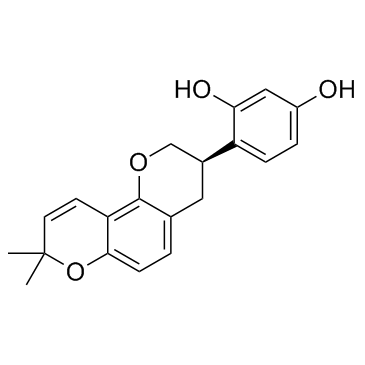Glabridin inhibits lipopolysaccharide-induced activation of a microglial cell line, BV-2, by blocking NF-kappaB and AP-1.
Sun Hong Park, Jong Soon Kang, Yeo Dae Yoon, Kiho Lee, Kang-Jeon Kim, Ki Hoon Lee, Chang Woo Lee, Eun-Yi Moon, Sang-Bae Han, Bong Hee Kim, Hwan Mook Kim, Song-Kyu Park
Index: Phytother Res. 24 Suppl 1 , S29-34, (2010)
Full Text: HTML
Abstract
Glabridin, a flavonoid present in licorice root, is known to have antiinflammatory and cardiovascular protective activities. The present study reports an inhibitory effect of glabridin on microglial activation. Glabridin dose-dependently attenuated lipopolysaccharide (LPS)-induced production of inflammatory mediators, including nitric oxide, tumor necrosis factor-alpha and interleukin-1beta, in BV-2 cells, a murine microglia cell line. Moreover, mRNA expression of these inflammatory mediators was also suppressed by glabridin in LPS-stimulated BV-2 cells. Further study demonstrated that glabridin inhibited LPS-induced DNA binding activity of NF-kappaB and AP-1 in BV-2 cells. Collectively, the results presented in this report demonstrate that glabridin inhibits the production of inflammatory mediators in BV-2 cells and this is mediated, at least in part, by blocking NF-kappaB and AP-1 activation. The results suggest that glabridin might be a potential therapeutic agent for the treatment of neuroinflammatory and neurodegenerative diseases.
Related Compounds
| Structure | Name/CAS No. | Molecular Formula | Articles |
|---|---|---|---|
 |
Glabridin
CAS:59870-68-7 |
C20H20O4 |
|
Glabridin inhibits migration and invasion by transcriptional...
2014-06-01 [Br. J. Pharmacol. 171(12) , 3037-50, (2014)] |
|
Novel phytonutrient contributors to antioxidant protection a...
2012-06-01 [Nutrition 28(6) , 605-10, (2012)] |
|
Glabridin inhibits migration, invasion, and angiogenesis of ...
2011-12-01 [Integr. Cancer Ther. 10(4) , 341-9, (2011)] |
|
Inhibition of bone marrow-derived dendritic cell maturation ...
2010-10-01 [Int. Immunopharmacol. 10(10) , 1185-93, (2010)] |
|
Phytochemistry and biological properties of glabridin.
2013-10-01 [Fitoterapia 90 , 160-84, (2013)] |